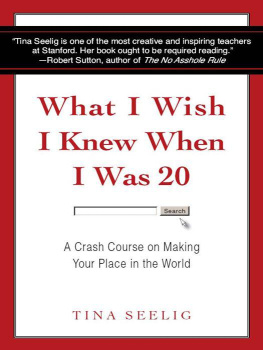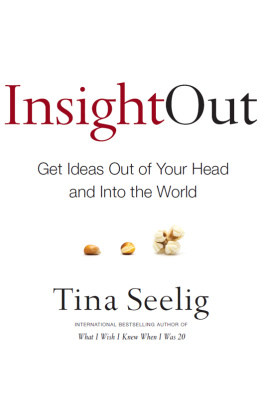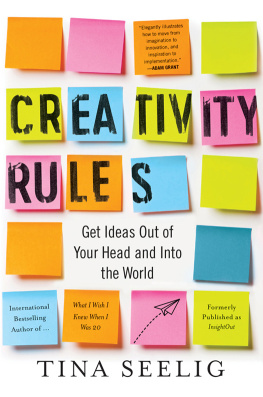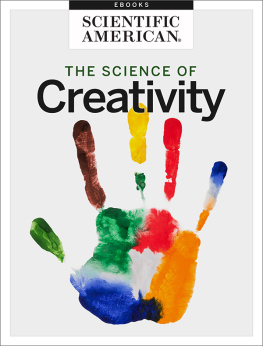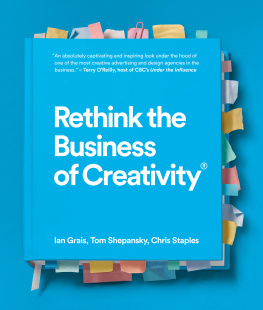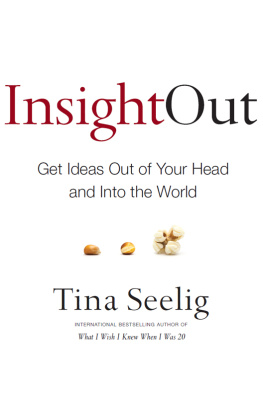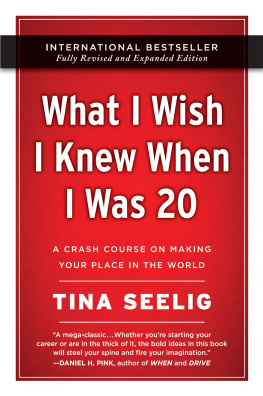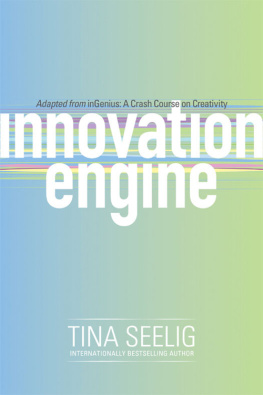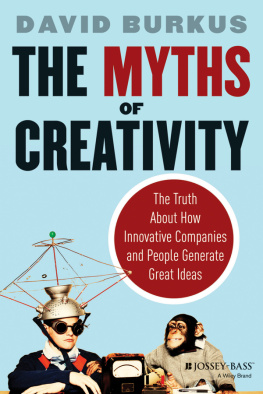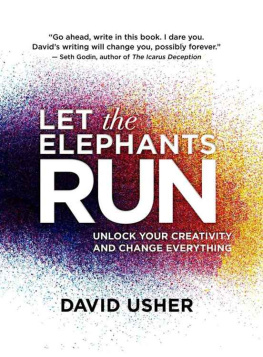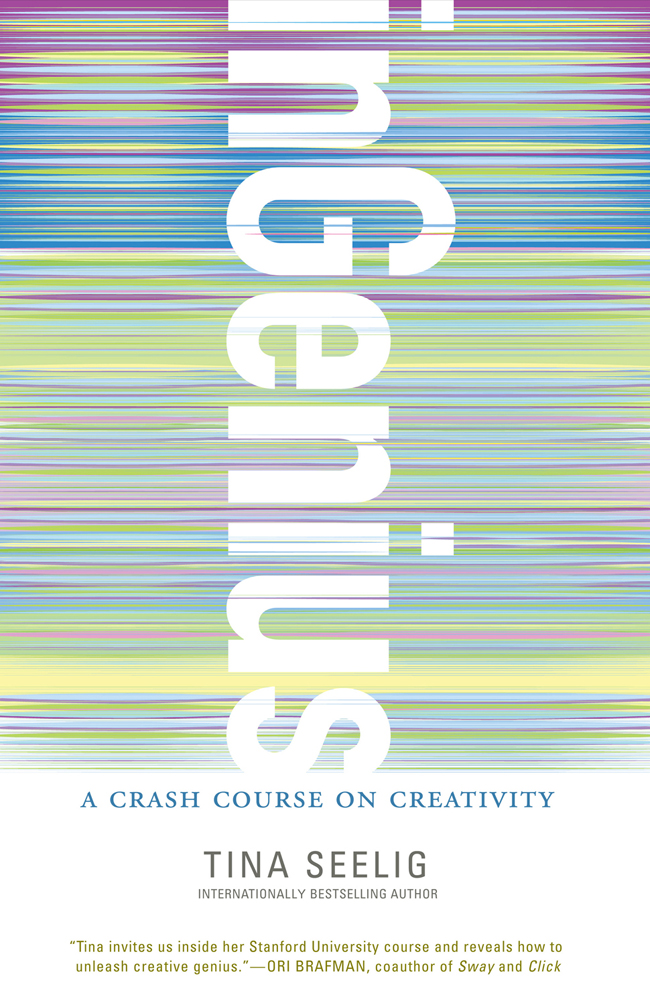
inGenius
A CRASH COURSE ON CREATIVITY
Tina Seelig

For sweet Sylvine
Contents
P rovocative. Just one word... provocative.
Until recently, prospective students at All Souls College, at Oxford University, took a one-word exam. The Essay, as it was called, was both anticipated and feared by applicants. They each flipped over a piece of paper at the same time to reveal a single word. The word might have been innocence or miracles or water or provocative. Their challenge was to craft an essay in three hours inspired by that single word.
There were no right answers to this exam. However, each applicants response provided insights into the students wealth of knowledge and ability to generate creative connections. The New York Times quotes one Oxford professor as saying, The unveiling of the word was once an event of such excitement that even nonapplicants reportedly gathered outside the college each year, waiting for news to waft out. This challenge reinforces the fact that everything every single word provides an opportunity to leverage what you know to stretch your imagination.
For so many of us, this type of creativity hasnt been fostered. We dont look at everything in our environment as an opportunity for ingenuity. In fact, creativity should be an imperative. Creativity allows you to thrive in an ever changing world and unlocks a universe of possibilities. With enhanced creativity, instead of problems you see potential, instead of obstacles you see opportunities, and instead of challenges you see a chance to create breakthrough solutions. Look around and it becomes clear that the innovators among us are the ones succeeding in every arena, from science and technology to education and the arts. Nevertheless, creative problem solving is rarely taught in school, or even considered a skill you can learn.
Sadly, there is also a common and often-repeated saying, Ideas are cheap. This statement discounts the value of creativity and is utterly wrong. Ideas arent cheap at alltheyre free. And theyre amazingly valuable. Ideas lead to innovations that fuel the economies of the world, and they prevent our lives from becoming repetitive and stagnant. They are the cranes that pull us out of well-worn ruts and put us on a path toward progress. Without creativity we are not just condemned to a life of repetition, but to a life that slips backward. In fact, the biggest failures of our lives are not those of execution, but failures of imagination. As the renowned American inventor Alan Kay famously said, The best way to predict the future is to invent it. We are all inventors of our own future. And creativity is at the heart of invention.
As demonstrated so beautifully by the one-word exam, every utterance, every object, every decision, and every action is an opportunity for creativity. This challenge, one of many tests given over several days at All Souls College, has been called the hardest exam in the world. It required both a breadth of knowledge and a healthy dose of imagination. Matthew Edward Harris, who took the exam in 2007, was assigned the word harmony. He wrote in the Daily Telegraph that he felt like a chef rummaging through the recesses of his refrigerator for unlikely soup ingredients. This homey simile is a wonderful reminder that these are skills that we have an opportunity to call upon every day as we face challenges as simple as making soup and as monumental as solving the massive problems that face the world.
I teach a course on creativity and innovation at the Hasso Plattner Institute of Design, affectionately called the d.school, in the Stanford School of Engineering. At STVP our mission is to provide students in all fields with the knowledge, skills, and attitudes needed to seize opportunities and creatively solve major world problems.
On the first day of class, we start with a very simple challenge: redesigning a name tag. I tell the students that I dont like name tags at all. The text is too small to read. They dont include the information I want to know. And theyre often hanging around the wearers belt buckle, which is really awkward. The students laugh when they realize that they too have been frustrated by the same problems.
Within fifteen minutes the class has replaced the name tags hanging around their necks with beautifully decorated pieces of paper with their names in large text. And the new name tags are pinned neatly to their shirts. Theyre pleased they have successfully solved the problem and are ready to go on to the next one. But I have something else in mind.... I collect all of the new name tags and put them in the shredder. The students look at me as though I have gone nuts!
I then ask, Why do we use name tags at all? At first, the students think that this is a preposterous question. Isnt the answer obvious? Of course, we use name tags so that others can see our name. They quickly realize, however, that theyve never thought about this question. After a short discussion, the students acknowledge that name tags serve a sophisticated set of functions, including stimulating conversations between people who dont know each other, helping to avoid the embarrassment of forgetting someones name, and allowing you to quickly learn about the person with whom you are talking.
With this expanded appreciation for the role of a name tag, students interview one another to learn how they want to engage with new people and how they want others to engage with them. These interviews provide fresh insights that lead them to create inventive new solutions that push beyond the limitations of a traditional name tag.
One team broke free from the size constraints of a tiny name tag and designed custom T-shirts with a mix of information about the wearer in both words and pictures. Featured were the places they had lived, the sports they played, their favorite music, and members of their families. They vastly expanded the concept of a name tag. Instead of wearing a tiny tag on their shirts, each shirt literally became a name tag, offering lots of topics to explore.
Another team realized that when you meet someone new, it would be helpful to have relevant information about that person fed to you on an as-needed basis to help keep the conversation going and to avoid embarrassing silences. They mocked up an earpiece that whispers information about the person with whom you are talking. It discreetly reveals helpful facts, such as how to pronounce the persons name, his or her place of employment, and the names of mutual friends.
Yet another team realized that in order to facilitate meaningful connections between people, it is often more important to know how the other person is feeling than it is to know a collection of facts about them. They designed a set of colored bracelets, each of which denotes a different mood. For example, a green ribbon means that you feel cheerful, a blue ribbon that you are melancholy, a red ribbon that youre stressed, and a purple ribbon that you feel fortunate. By combining the different colored ribbons, a wide range of emotions can be quickly communicated to others, facilitating a more meaningful first connection.
This assignment is designed to demonstrate an important point: there are opportunities for creative problem solving everywhere. Anything in the world can inspire ingenious ideaseven a simple name tag. Take a look around your office, your classroom, your bedroom, or your backyard. Everything you see is ripe for innovation.
Creativity is an endless renewable resource, and we can tap into it at any time. As children we naturally draw upon our imagination and curiosity in an attempt to make sense of the complicated world around us. We experiment with everything in our midst, dropping things to see how far they fall, banging things to see how they sound, and touching all the things we can get our hands on to see how they feel. We mix together random ingredients in the kitchen to see how they taste, make up games with our friends, and imagine what it would be like to live on other planets. Essentially, we have both creative competence and confidence; and the adults around us encourage our creative endeavors, building environments that tickle our imagination.
Next page

